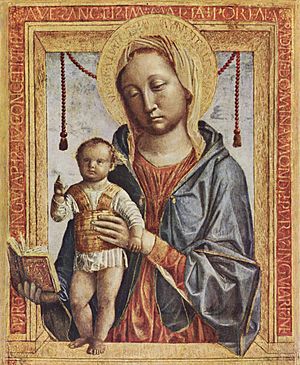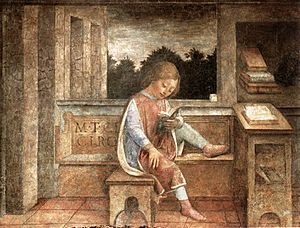Vincenzo Foppa facts for kids
Quick facts for kids
Vincenzo Foppa
|
|
|---|---|

Virgin of the Book c. 1475, Milan
|
|
| Born |
Vincenzo Foppa
c. 1427–1430 |
| Died | c. 1515–1516 (aged 84–89) |
| Nationality | Italian |
|
Notable work
|
Crucifixion Portinari Chapel The Young Cicero Reading Adoration of the Kings |
| Movement | Italian Renaissance |
Vincenzo Foppa (born around 1427–1430, died around 1515–1516) was an Italian painter. He lived during the Renaissance, a time of great art and learning. Even though not many of his paintings still exist, he was very important. Many people admired his work.
Foppa was known as the main artist of the Early Lombard School. This was a special style of painting from the Lombardy region of Italy. He worked for the powerful Sforza family, who were dukes of Milan. He also painted for other important people in different parts of Italy. In his later years, he lived and worked in his hometown of Brescia.
Contents
Vincenzo Foppa's Early Life
We don't know much about Vincenzo Foppa's early life. He was born in Brescia, Italy. At that time, Brescia didn't have many famous painters. So, Foppa probably had to go somewhere else to learn how to paint.
He might have seen paintings by Gentile da Fabriano. He was also likely influenced by Jacopo Bellini, another artist. Some people think Foppa might have learned directly from Bellini. He might also have trained with Bonifacio Bembo. It's most likely that Foppa went to Verona for his art training.
Becoming a Famous Painter
First Paintings and Style
Foppa's earliest known painting is The Madonna and Child with Angels. This painting looks a bit like the art from Verona. This makes people think he trained there. But the painting also shows Foppa's own style. For example, the skin tones in his paintings often looked grayish. This became a special feature of the Lombard school.
His next known work is his Crucifixion, painted in 1456. In this painting, his human figures look much more real. This shows how much he improved. This painting is very similar to one by Jacopo Bellini. This supports the idea that Foppa might have trained with Bellini. Even at this early stage, Foppa showed great talent.
Working in Pavia and Genoa
By 1456, Vincenzo Foppa was working as an artist on his own. He moved to Pavia by 1458. He was married to Caylina and had children. The art scene in Pavia was better than in Brescia.
The Sforza family hired Foppa to work in Pavia. He made a good impression on Duke Francesco I Sforza. The Duke even wrote a letter praising Foppa. This letter helped Foppa get work in Genoa. He painted frescos (wall paintings) in the Chapel of St. John the Baptist.
Foppa went to Genoa in 1461 to avoid the plague in Pavia. He returned to Pavia in 1462. He finished the Chapel in 1471, but all his work there was later lost. He also painted other works that have since disappeared.
Painting for Important Families in Milan
In 1463, Francesco Sforza asked Foppa to come to Milan. One of his first jobs was a fresco for a new hospital. It showed the Sforza family starting the hospital. The architect of the hospital, Filarete, called Foppa one of the greatest painters. Foppa was the only painter from Lombardy to get this honor.
After that, Foppa painted frescoes for the Medici Bank in Milan. This was a building given by Francesco Sforza to Cosimo de' Medici. Foppa started this work in 1464 and finished it by 1467. The frescoes included paintings of Roman emperors. There was also a portrait of Francesco Sforza and his family.
The only fresco from this building that still exists shows a small boy reading. It's called The Young Cicero Reading. This is the only non-religious painting by Foppa that we still have today. It's in the Wallace Collection in London.
In 1468, Foppa was asked to decorate the Portinari Chapel in Milan. This chapel holds the remains of a saint. Foppa is believed to have painted the fresco series Life of St. Peter Martyr there. His work in the Chapel also includes paintings of important church leaders and saints. The frescoes in the Chapel show Foppa's amazing use of perspective. This made the scenes look very real.
After Duke Francesco died, his son Galeazzo Maria Sforza continued to work with Foppa. He made Foppa a member of his royal household. The new Duke also gave Foppa special permission to travel without paying taxes.
Foppa returned to Brescia in 1472 to paint an altarpiece. But he was back in Milan by 1473. He painted several Madonna paintings around this time. These paintings often looked like sculptures. This shows the influence of sculptors like Donatello.
Back to Pavia
In 1474, Foppa worked with other artists on a large altarpiece for the Castello of Pavia. But the work stopped when Duke Galeazzo Sforza was killed in 1476. Some parts of this project might still exist today.
Foppa became famous for his paintings of the Virgin and Child. He continued to paint them for the rest of his career. Many of these paintings show Mary holding baby Jesus. They are often in front of a curtain or a landscape.
He also did several works for Santa Maria di Brera in Milan. These included a large painting called Virgin and Child with Saints (around 1476). He also painted a fresco of Saint Sebastian. By 1486, Foppa finished the Bottigella Altarpiece. It showed a family praying to the Virgin Mary.
His Final Years as an Artist
By 1489, Foppa was back in Liguria, painting an altarpiece that is now lost. The next year, he finished another altarpiece in Savona. This work was for Giuliano della Rovere, who often hired Foppa.
In 1490, Foppa was given money each year by Brescia. This was so he would keep painting for the city. This marked his return home. He continued to paint many religious works in his last years. He spent most of his time in Brescia and Pavia. His last known work is from 1514. He is believed to have died in 1515 or 1516 in Brescia.
What Made His Art Special?
Foppa's style was influenced by other artists like Bellini and Mantegna. His human figures often had a silvery-gray skin tone. This became a special feature of the Lombard school. This coloring made his subjects look almost ghostly.
Foppa was praised for how he used perspective, light, and colors. In his Adoration of the Kings, he used a special technique called pastiglia. This is like paste-work that adds depth to the painting. He also used sgraffito. This is where he put gold leaf under the paint. Then he scraped off the paint to make crowns look truly golden.
Most of Foppa's known works are religious. He often painted the Virgin with Child. He didn't paint many other subjects. This might be because he depended on what people asked him to paint. Also, many of his large wall paintings have been lost over time. Most of the works that survived are smaller religious pieces.
His Impact on Art
Foppa was known as the greatest painter of his time in Lombardy. He is seen as the founder of the Early Lombard School. Before him, art existed in Pavia and Milan. But Foppa's work gave Lombard art its own unique style.
From the 1460s to the 1480s, he was the most important artist in Lombardy. People admired him, including his wealthy patrons and other artists. Foppa was confident in his skills. He sometimes left jobs unfinished to find more interesting or better-paying work.
Many artists were influenced by Foppa, like Vincenzo Civerchio and Ambrogio Bergognone. However, his long-term influence changed when Leonardo da Vinci arrived in Milan in 1482. Leonardo's huge talent changed the art world. This made Foppa's style seem less important. Also, many of Foppa's paintings have been lost. This makes it harder for us to appreciate his full impact today.
Some of His Famous Artworks
- Madonna and Child with Angels, c.1450, Florence, Berenson Collection
- Crucifixion, 1456, Bergamo, Accademia Carrara
- St. Jerome Penitent, c.1460, Bergamo, Accademia Carrara
- Madonna of the Book, 1460–1468, Milan, Pinacoteca del Castello Sforzesco
- Madonna and Child, 1460–1470, Berlin, Staatliche Museen
- Boy Reading Cicero, c. 1464, London, Wallace Collection
- Frescoes of the Portinari Chapel, 1464–1468, Milan, Basilica of Sant'Eustorgio
- Four Doctors of the Church
- Eight Busts of Saints
- Four Scenes from the Life of St. Peter Martyr :
- Cloud Miracle
- Miracle of the False Madonna
- Miracle of Narni
- Martyrdom of Saint Peter of Verona
- Annunciation
- Assumption of the Virgin
- St. Augustine, 1465–1470, Milan, Pinacoteca del Castello Sforzesco
- St. Theodore, 1465–1470, Milan, Pinacoteca del Castello Sforzesco
- St. Christopher, c.1470, Denver, Denver Art Museum
- Evangelists, 1477, Brescia, Carmelite Church of Santa Maria, Averoldi chapel
- Madonna and Child with an Angel, 1479–1480, Florence, Uffizi
- Bottigella Altarpiece, c.1486, Pavia, Civic Museums
- St. Francis receiving the stigmata and St. Giovanni Battista, 1488–1489, Milan, Pinacoteca del Castello Sforzesco
- Saint Sebastian, c.1489, Milan, Pinacoteca di Brera
- Madonna and Child in a Landscape, c.1490, Philadelphia, Philadelphia Museum of Art
- Altarpiece, c.1490, Oratory of Our Lady of the Castle, Savona, with Ludovico Brea
- Madonna and Child, 1490–1495, Milan, Museo Poldi Pezzoli
- Madonna and Child, 1492, Brescia, Chiesa di Santa Maria Assunta di Chiesanuova
- Martyrdom of St. Sebastian, c.1485, Milan, Pinacoteca del Castello Sforzesco
- Portrait of Giovanni Francesco Brivio, 1495, Milan, Museo Poldi Pezzoli
- Portrait of an Old Gentleman, 1495–1500, Philadelphia, Philadelphia Museum of Art
- St. Anthony of Padua, 1495–1500, Washington, National Gallery of Art
- San Bernardino of Siena, 1495–1500, Washington, National Gallery of Art
- Altarpiece of Santa Maria delle Grazie, 1500–1510, Milan, Pinacoteca di Brera
- Adoration of the Magi, c.1500, London, National Gallery
Images for kids
See also
 In Spanish: Vincenzo Foppa para niños
In Spanish: Vincenzo Foppa para niños










